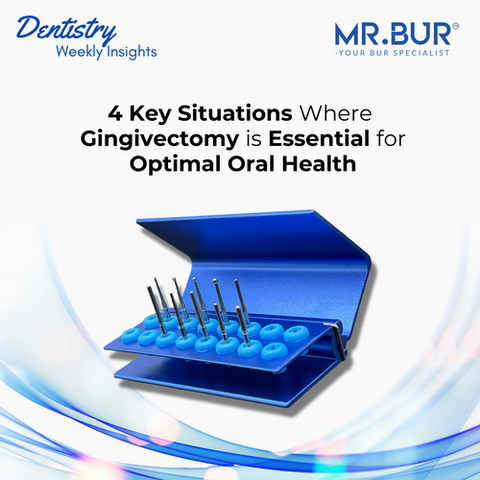Introduction to IPR in Orthodontics
Interproximal reduction (IPR) is an essential procedure in orthodontics to create space by reducing enamel between teeth, especially in crowded cases. The precision required during IPR has a significant impact on enamel and periodontal health, making proper technique and tools essential.
What to Expect:
- Importance of precision in IPR for enamel and periodontal health.
- Long-term effects of enamel reduction and potential risks.
- Insights into modern IPR techniques and technologies.
For an in-depth exploration of precision techniques in IPR, refer to Unlocking Precision Dentistry: 10 Advantages of IPR Burs.
Biomechanical Properties of Enamel After IPR
Enamel is the hardest tissue in the human body, and its structural integrity is vital to maintaining tooth strength. IPR inevitably reduces enamel thickness, altering its biomechanical properties:
- Enamel Hardness and Surface Roughness: After IPR, enamel tends to lose hardness and becomes more prone to surface roughness, which can increase the risk of fractures.
- Post-IPR Examination: Advanced imaging technologies like SEM and micro-CT scans are often used to assess the impact of IPR on enamel. They provide detailed insights into changes in enamel hardness, surface texture, and structural integrity.
Impact of IPR on Periodontal Health
IPR also affects the periodontal tissues surrounding the teeth. The proximity of the gingiva and bone to the interproximal space makes it critical to perform IPR without damaging these structures. If improper techniques or inappropriate bur designs are used, the surrounding gingival tissues can become inflamed or damaged, leading to potential bone loss or periodontal disease.
Long-term periodontal health is contingent on precision in the IPR process. Research has demonstrated that poor IPR techniques can lead to increased plaque retention and loss of periodontal attachment.
IPR Bur and Their Influence on Tooth Integrity
IPR bur is critical to ensuring both the quality and safety of enamel reduction. Fine-grit burs are particularly valued for their precision, as they create smoother surfaces and reduce the risk of over-reduction, which is essential for maintaining tooth integrity. In contrast, coarse-grit burs, while faster, can remove excess enamel.
To address these concerns, Mr. Bur's Interproximal Reduction Series offers innovative IPR burs designed to optimize the balance between efficiency and safety. These include IPR burs like the X03W - X03SF for anterior and XL04 and XL05 for posterior, all engineered to reduce friction, minimize heat, and ensure precise enamel reduction.
Mr. Bur's One Slice IPR Kit
The One Slice IPR Kit is designed for anterior and posterior interproximal reduction, offering burs in various head sizes to accommodate different clinical needs:
- Anterior: X03W (0.3mm), X04R(0.4mm), X05B (0.5mm), and X03SF (Super Fine, 0.3mm) are ideal for creating space in the front teeth with exceptional control.
- Posterior: XL04 (0.45mm) and XL05 (0.5mm) are designed for use in the back teeth, ensuring efficient reduction while preserving the structural integrity of the adjacent teeth.
Biological Reactions to Enamel Reduction
- Tooth sensitivity is common after IPR, especially if excessive enamel is removed or the surface remains rough.
- Enamel loss can lead to demineralization, increasing the tooth's vulnerability to caries.
- Remineralizing agents like fluoride varnish can help restore lost minerals and protect enamel after IPR.
- IPR increases surface area for bacteria to adhere, potentially leading to plaque buildup if the enamel is not polished correctly.
- Post-IPR polishing is crucial to smooth the enamel surface and reduce the risk of future caries or periodontal disease.
Long-Term Effects on Occlusion and Tooth Stability
IPR is often performed to improve occlusion and prevent future dental crowding. However, long-term studies suggest that reducing interproximal enamel can impact tooth stability. Over time, teeth that have undergone IPR may show more wear, particularly if occlusal forces are not evenly distributed.
Longitudinal studies following patients who have undergone IPR show varying outcomes. Some patients experience excellent long-term stability, while others may require follow-up orthodontic treatments to correct shifting teeth or occlusal issues. Therefore, careful treatment planning, including the extent and location of IPR, is essential to ensure long-term tooth stability and health.
IPR and Caries Risk Assessment
- Increased caries risk is a primary concern with Interproximal Reduction (IPR) due to reduced enamel thickness.
- Thinner enamel is more prone to plaque accumulation and caries formation.
- Enamel reduced during IPR can develop microcracks and rough surfaces, creating ideal conditions for bacterial growth.
- Polishing post-IPR smooths the enamel surface, reducing the risk of plaque retention.
- Applying fluoride varnish after IPR helps remineralize enamel and provides additional protection against caries.
Minimally Invasive IPR Techniques
Minimally invasive techniques for IPR are becoming increasingly popular, thanks to advancements in digital dentistry and CAD/CAM technology. Digital IPR planning allows orthodontists to assess the precise amount of enamel that needs to be removed, reducing the risks associated with over-reduction.
Guided IPR is a technique where digital scans are used to pre-plan the reduction. This method ensures that only the necessary enamel is removed, preserving as much tooth structure as possible. Some practices also use AI-driven technology to enhance the precision of IPR, further minimizing risks to both enamel and periodontal tissues.
Therefore, Mr. Bur has created this groundbreaking IPR kit that has transformed orthodontics, cosmetic dentistry, and restorative procedures for the past. They offer exceptional precision, efficiency, and patient comfort while preserving healthy tooth structure. So choosing the best quality IPR burs is essential for all dentists, and that is why Mr. Bur is the right choice because their IPR burs is synonymous with excellence, earning the trust of dentists worldwide. With Mr. Bur's IPR kits at your disposal, you can provide extraordinary care, ensuring your patients leave with not only healthier smiles but also profound confidence. Elevate your practice and experience the myriad advantages of IPR burs with Mr. Bur Australia.
Clinical Guidelines for Optimal IPR Practice
To achieve the best results from IPR, clinicians should follow evidence-based guidelines. The choice of bur, whether fine or coarse, should be based on the specific needs of the patient.
After IPR, polishing is essential to smooth the enamel and reduce the risk of caries and sensitivity. Applying fluoride or other remineralizing agents can further protect the enamel. Regular follow-up is also necessary to monitor the long-term effects of IPR on both the teeth and the periodontium.
Have you implemented these advanced IPR techniques in your practice? Stay ahead in your field and explore the latest innovations in IPR burs today!
At MR. BUR AUSTRALIA, our strict adherence to relevant regulations guarantees our commitment to quality and safety.
You may also like:
Step-by-step guide to Interproximal Bur Technique: The Bur Used for IPR.
Diamond Burs, Carbide Burs, Surgical & Lab Use Burs, Endodontic burs, IPR Kit, Crown Cutting Kit, Gingivectomy Kit, Root Planning Kit, Orthodontic Kit, Composite Polishers, High Speed Burs, Low Speed Burs
Subscribe our newsletter now!





